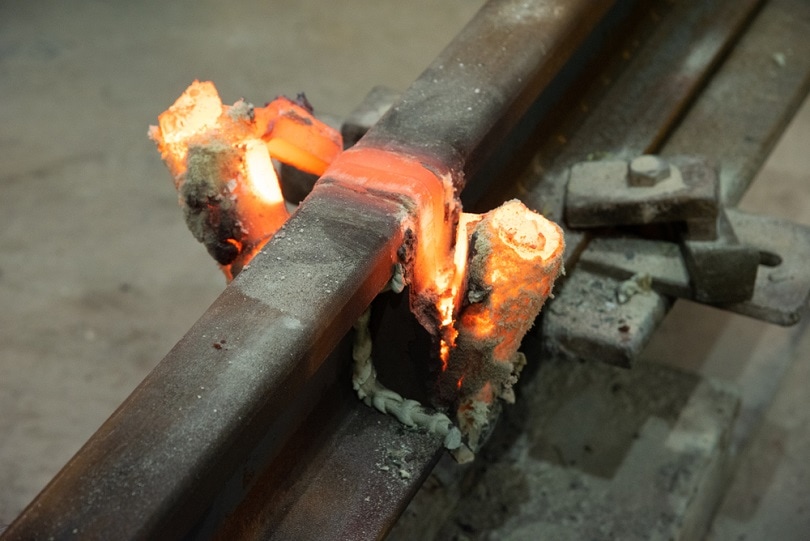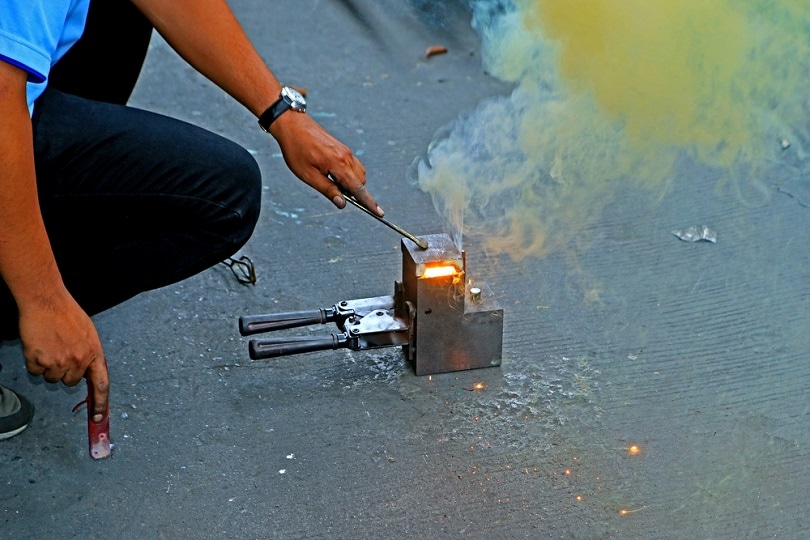What is Cad Welding, and How Does It Work?
Last Updated on

Cadweld is a brand name for the exothermic welding process. This is a process most often used to form strong bonds where arc welding would induce too much heat into the joint. Exothermic welding is often hidden from sight, since one of the most common applications is the joining of large cables, such as copper wire. But exothermic welding, though we don’t notice it that often, allows things like electrical connections to endure a long time.
Perhaps the biggest advantage to CAD welding is that it does not weaken the electrical conductivity in copper wiring. If the copper were to be welded with a different metal or alloy, the current would not be able to travel as well. Let’s take a look and see how Cadweld exothermic welding works.
How does it work?
Cadweld utilizes a precast, clampable mold to hold two metal rods together in a variety of joint configurations. Usually, they are butting against each other, but T-joints are also common. After the joint members are inserted into the mold, the mold is clamped together, and a sealing compound is placed around the entry point of the metal pieces. This prevents any of the weld metal from escaping during the welding process.

Then thermite, which is a combination of the selected filler metal and an oxidization agent, is inserted into the top of the precast mold. The mold is then closed from the top. After this is all ready to go, a heating torch is used to start the reaction and begin the weld. The molten metal spills from the upper chamber in the mold down to the weld cavity and forms the weld around the two pieces of metal.
There can be a lot of smoke during the process. Some explosions are known to occur so personal protective equipment such as gloves and safety glasses must be worn at all times as well as keeping your distance during the process.
After the weld is complete, the mold is unclamped. There will be slag leftover from the weld on the inside. This must all be cleaned out with a wire brush before setting up the mold again for another weld.
What are the different types of CAD Welding?
- Rail Welding
Credit: Kapuska, Shutterstock
This utilizes the same essential equipment as the Cadweld process that we have discussed thus far. However, since rails used for locomotives are much larger than copper cables and rebar, the equipment has to be much larger as well. There is usually a larger mold that is situated from either side around the joint in the rails. But the reaction that occurs is not contained within the mold. Instead, the thermite is deposited into a refractory crucible that then pours the molten metal into the mold.
The equipment is removed from the rail while it is still cooling so that the excess can be knocked off with a sledgehammer easily. The remaining solidified metal reinforcement is then ground off with a grinder so that the joint surface is flush. See a demonstration of this process here.
- Cadweld
Credit: Nutthapat Matphongtavorn, Shutterstock
This development of this process which we have already discussed briefly was preceded by the messier and more dangerous thermite welding that is used in rail welding. Cadweld, for the most part, is self-contained. The filler metal and activator often come prepackaged so there is no need to measure out how much will be needed for each weld.
Where is it used?
- Copper
This is one of the preferred methods for welding copper together since it neither damages it nor lessens conductivity since it produces a copper purity unmatched by other processes. The conductivity can be weaker if the metal is not as pure. Copper wire can be found in equipment that is used for power distribution. It is also heavily used in transit, such as bus rails and racks.
- Electronics
Related to exothermic welding is a process called exothermic brazing. This is where exothermic reactions are used to bond wires using various alloyed metals and solder filler metals. The process is similar to exothermic welding in that it uses a filler metal with a metal oxide to cause the reaction. This brazing process involves heat input only for a short moment so that there is neither damage nor distortion to the sensitive electronic materials.
- Galvanized Cable
According to the United States National Electrical code, the only acceptable method for bonding copper to galvanized cable is by using exothermic welding. Galvanized material generally does not have as great of conductivity as bare metals, since there is a zinc coating. Galvanization usually has to be ground off if any welding is to be done on galvanized material. The galvanized coating also will introduce porosity and other defects into the weld. But this is avoided with exothermic welding. But according to the NEC, all of these welds have to be X-ray tested as well.
- Increased conductivity of cables and wires
- Long lasting connection
- Often comes with prepackaged thermite
- Takes relatively little skill to accomplish
- Can be dangerous depending on the application
- Certain environmental conditions are not ideal for proper welding
Frequently Asked Questions (FAQs)
What is the temperature of thermite welding?
The temperature of thermite welding is in the ballpark of 4,000°F. This is about 7,000°F less than an arc welding process. But it is still hot enough to form the strong bond necessary.
Can you CAD weld in the rain?
It is not recommended that you CAD weld in the rain, even though it is a self-contained process. Water can get inside the chamber and cause unnecessary defects. If you are going to CAD weld in the rain, ensure that it is dry as possible around the welding.
Do CAD weld shots expire?
A CAD weld shot is the prepackaged filler material that is inserted into the mold. If proper storage conditions are maintained per the manufacturer’s intent, then the shots should not expire.
Final Thoughts
We are used to seeing arc welding which relies upon electricity to perform the necessary fusion. But welding of some form or another dates back thousands of years. The curious thing about exothermic welding is how fundamental it seems, yet we still rely on it to secure electrical connections. Some technologies we never seem to outgrow, and they continually prove themselves necessary.
Featured image credit: Duke.of.arcH, Shutterstock


